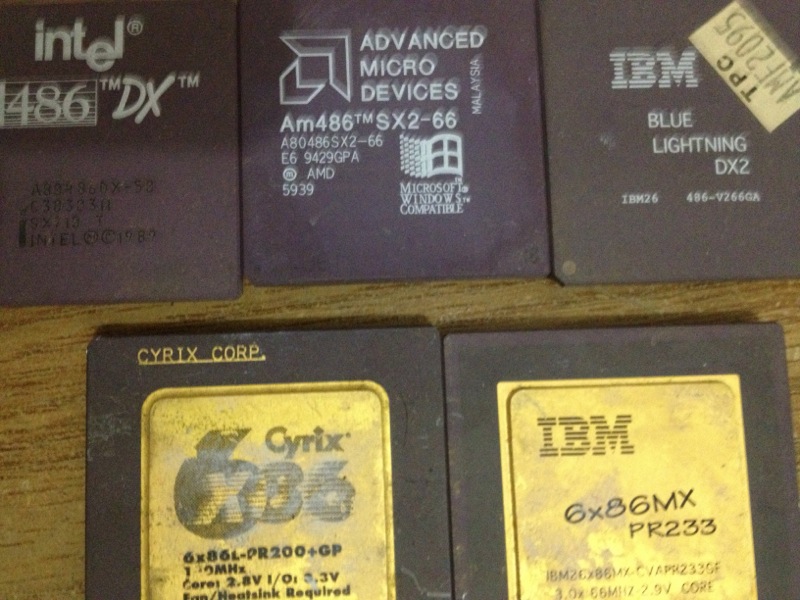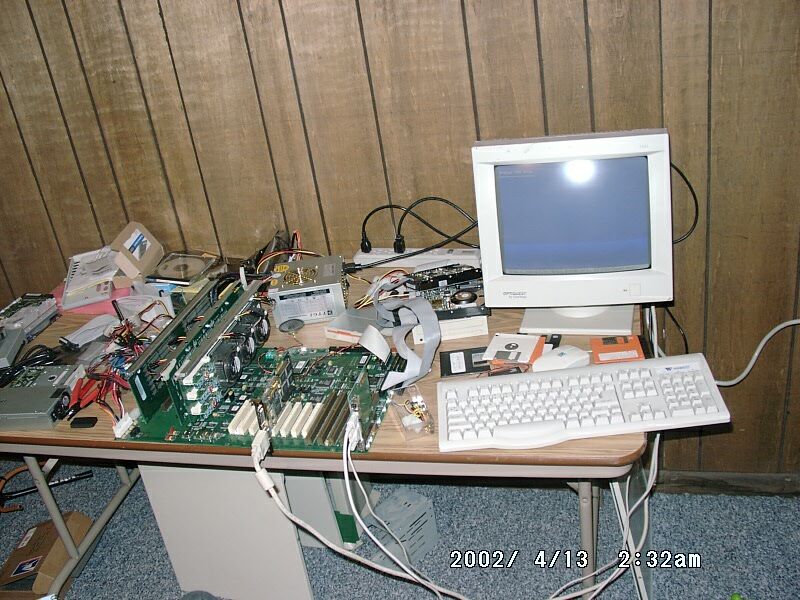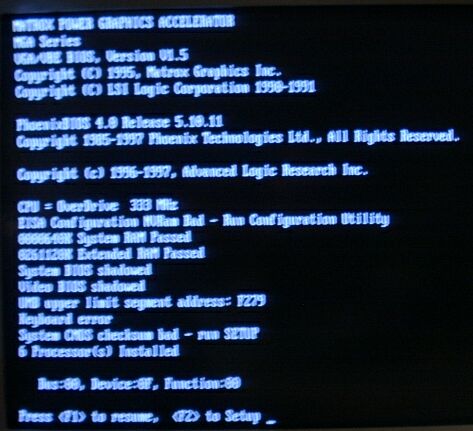feipoa wrote:The closest I can find from the Cyrix literature is: […]
Show full quote
The closest I can find from the Cyrix literature is:
6x86MX - PR233GP 3x66
6x86MX - PR266GP 3x75
6x86MX - PR266GP 3.5x66
MII - PR266 2.5x83
However, there seem to be plenty differant collectors who have an MII-266GP 3x66
http://www.chipdb.org/cat-266-173.htm
Cyrix has, at times, changed their own PR ratings, so the MII-266GP may be one such CPU.
Yes, as with the 3x83 MHz 333 vs 350, and per the 3x75 and 3.5x66 PR300 (vs the 266s you listed -and 266 probably would have been a more realistic rating).
Apparently there were some actual architectural improvements that led to re-rating some speed grades, but there also seems to be a general trend of less stringent ratings for the late Cyrix parts. (especially compared to the early ones that benchmarked faster than the Pentium equivalent -ie PR166 being comfortably faster than a Pentium 166 in integer performance)
On another note: looking around at some comments and comparisons on the FPU performance of the 6x86 vs Intel and AMD parts: the clock per clock performance of the FPU seems to be roughly equal to the K6 and P5 Pentium, but also application-dependent (there's disproportional performance for different operations).
In particular, if wiki's cycle time charts are accurate: http://en.wikipedia.org/wiki/X87
It shows that the 6x86 FPU is considerably slower at FMUL and FADD than the P5 (4 vs 1 cycle minimum), but noticeably faster for FDIV (which is a much more intensive operation in general at 24 vs 39 cycles minimum) and the P6 FPU is actually slower than the P5 in FMUL (2 min) but much faster in FDIV (16/17 min). For many multimedia applications (and especially 3D games), multiplication and division performance are major factors, so the slower FMUL (and add) could be mitigated (or even surpassed) by the FDIV performance. (and in the case of the P6's generally higher FPU benchmarks vs P5, this definitely seems to hold true -albeit the advantage to the 6x86 is much more modest and it's obviously at a universal disadvantage to the P6 FPU)
Also, given that general performance for the 6x86 FPU, had Cyrix extended the architecture to a pipelined dual-issue FPU derived from the same FPU logic, the performance probably would have roughly matched the P6 FPU clock for clock (or slightly exceeded it for some applications). Granted, they apparently did just that with the MIII Jalapeno/Cayenne core -along with 3DNow! and 256k L2 cache, but that was obviously much too late. (and, of course, went unreleased by VIA in favor of the WinChip III)
mwdmeyer wrote:Ha thanks. Yeah I believe I built my first computer (well pulled apart and rebuilt) when I was 6 years old, an old 12MHz 286.
Most of my first computers came from my dad's work when they would throw them out. I loved those days. He would tell me the day before that he would get me a computer from the office. The best time was when he said they were throwing away some 386s (I was running a 386SX 33MHz with 4mb of Ram), The next morning I ran down stairs to see what he had gotten me, it was a 486 DX33 with 8mb Ram, I was so happy!
We did some of that at home when I was growing up too, but I didn't build my firs system until I was 10 (on new year's eve 1999), and I didn't know that much about the in-depth technical side of things until much later. (I knew some basic stuff, and how the case/peripherals/components fit together, but I didn't know more detailed things about the CPU, board, RAM, etc, and I always had help from my dad)
I don't think any of our systems were really like yours, but we did get a fair amount of discarded company parts/machines and my dad did a lot of bargain hunting with used parts, sales and wholesale dealers.
Then again, one oddity was our first shared family multimedia computer from 1993/94 . . . it was pretty powerful inside (fast 486, CD-ROM, decent amount of RAM, good sound -I think a Pro Audio Spectrum, DOS+Win3.x), but it used a mixed of parts (including a late 80s vintage baby AT case) and a 14" grayscale VGA monitor with a crack in the vents on the top/back. (so a pretty nice multimedia/gaming PC using a grayscale monitor 😉 -and we didn't get a color monitor for that machine until late 1995)
That old AT box was used as the shared family PC until 1999 when my dad built a new one (ATX iirc) and we rebuilt the AT box into my first PC. (I believe it was a K6-2 300 on a FIC503A and a Rage Pro PCI card -I forget how much RAM or if it had DVD -I think it was just CD, though the family PC had DVD at that point) That later got upgraded to a K6-2 550 (or 2+) and it sits as such (still working) in the garage at home.
All my first computers were an odd configuration as I could never afford a full machine but I did purchase upgrades from time to time. For example my Pentium 133 had 3 video cards in its life time. A 2mb S3 Trio, 4mb SiS 6326 and then finally a TNT2M64 32mb (I played half life on that machine!).
My machines tended to be made from hand-me-downs from my dad and/or the shared family PC (with a few exceptions where my dad upgraded things with newly obtained -though not always new- parts; and much more recently when I started buying my own parts).
I never did get the Cyrix running with a 75MHz FSB on the VX motherboard. I tried and I believe the system reported as a PR166, it was such a long time ago now!
Running at 133 MHz (PR166) on top of being a VX board definitely would explain the worse-than-P133 gaming performance. (at 150/75, there probably would have been a noticeable improvement, even for FPU-intensive stuff)
The Cyrix + Motherboard was $50 I believe. So not a bad deal. Just wished it was a Pentium 200 😀
$50 including another motherboard (aside from the VX board)?
The PR200 probably wouldn't have been nearly as disappointing on a well-matched board and 75 MHz. (though, given the timing and existing VX board, it probably would have made more sense to look for a used Petium MMX 166 or 200 in the $50 range, or a WinChip 2)
My first new computer was when I purchased a Motherboard + Case + CPU + Ram. It was a AMD Duron 800MHz, Gigabyte GA-7IXE4 (http://ee.gigabyte.com/products/page/mb/ga-7ixe4/) and 64mb Ram. I used the Sound Card, Hard Drive, Video Card and Network Card from the Pentium 133! In fact it was somewhat a step down as my Pentium 133 had something crazy like 90-128mb ram in it towards the end of its life (started with 24mb).
Funny that you mention that. A couple weeks ago, I gave 4 of our old EDO SIMMs to a friend (actually Apolloboy on these forums) to use in his Pentium 133 retro gaming box, hoping to get up to 32 MB (I'd assumed they were 8 MB SIMMs). As it turned out, they were 32 MB SIMMs, so when he booted it up, we were pleasantly surprised to find 128 MB installed. 😀


